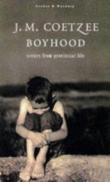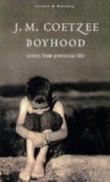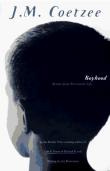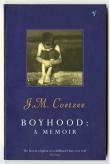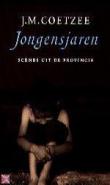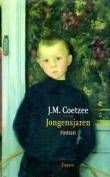AustLit
Latest Issues
AbstractHistoryArchive Description
Coetzee has been reluctant to talk about himself. Now, revisiting the South Africa of a half century ago, he writes about his childhood and his own interior life. Boyhood's young narrator grew up in a new development north of Cape Town, tormented by guilt and fear. With a father he did not respect, and a mother he both adored and resented, he led a double life - at school the brilliant and well-behaved student, at home the princely despot, always terrified of losing his mother's love. His first encounters with literature, the awakenings of sexual desire, and a growing awareness of apartheid left him with baffling questions; and only in his love of the veld ("farms are places of freedom, of life") could he find a sense of belonging. Bold and telling, this masterly evocation of a young boy's life is the book Coetzee's many admirers have been waiting for, but never could have expected (Source: Libraries Australia).
Notes
-
Boyhood is the first in Coetzee's memoir trilogy, which also includes Youth and Summertime. All three books were revised and published collectively under the title Scenes from Provincial Life~ in 2011.
-
Editions and translations were updated for Boyhood: Scenes from Provincial Life by Eilish Copelin as part of a Semester 2, 2013 student internship. The selection and inclusion of these editions and translations was based on their availability through Australian libraries, namely through the search facilities of Libraries Australia and Trove (National Library of Australia).
It has been further extended in the course of a 2014/15 project to create a comprehensive bibliography of Coetzee's works. We believe the record for the novel and its relationship to the revised version in Scenes of Provincial Life is comprehensive. However, due to the enormous breadth of critical material on Coetzee's work, indexing of secondary sources is not complete.
We are grateful for the author's and Indiana University's Professor Breon Mitchell's assistance in compiling this record.
Contents
- Introduction, single work essay
Publication Details of Only Known VersionEarliest 2 Known Versions of
Works about this Work
-
J. M. Coetzee : Politics of the Child, Politics of Nonposition
2020
single work
criticism
— Appears in: Textual Practice , vol. 34 no. 6 2020; (p. 975-993)'This article explores the political resonance of the child figure in J. M. Coetzee’s writing by linking the two child characters in his fictional memoir Boyhood (1997) and his recent fiction The Childhood of Jesus (2013). Mirroring some recurring themes and motifs in Coetzee’s early novels, the trope of childhood and the issue of education, as I observe, have become increasingly important, since the late and post-apartheid era, in the author’s ongoing critique of colonialist and neocolonialist forms of power. This article will discuss the ideological dimension and the subversive potentiality embedded in this particular literary trope through the concept of political ‘nonposition’. Developed by Coetzee himself in his critical essays and often associated with the trope of the child, the notion of ‘nonposition’ is significant to understand Coetzee’s novelistic discourse as a form of non-sectarian political participation. Tracing Coetzee’s Australian-phase writing back to post-apartheid South Africa, this article also illuminates part of a continuous trajectory in Coetzee’s oeuvre that will shed light on the politics of his highly self-reflexive metafictional literary practice in general, which has been substantially informed by South African history and politics preceding his emigration to Australia and the development of his late style.'(Publication abstract)
-
A Writer’s Manifesto : Articulating Ways of Learning to Write Well
2020
single work
criticism
— Appears in: New Writing , vol. 17 no. 1 2020; (p. 71-79)'A writer’s manifesto is a statement outlining a writer’s philosophy of life, writing goals and intentions, motives, and sources of inspiration. It is also an ongoing self-reflection on how a writer learns to write well. A writing manifesto demands an interrogation of the literary, political, philosophical and material contexts of a writer’s practice. This paper demonstrates how both undergraduate and post-graduate students can steer their own writing growth by writing a manifesto through an exploration of various methods of writing practice.' (Publication abstract)
-
Writing the Self as Other : Autrebiography
2019
single work
criticism
— Appears in: TEXT : The Journal of the Australian Association of Writing Programs , October vol. 23 no. 2 2019; 'According to Roland Barthes, the autobiographic act of remembering and reclaiming the past commits the fallacy of conflating the author, narrator and protagonist, and giving the first two power over the latter. The past self is a fictional ‘other’, and the writing of memoir is a reading of the past self as a text. JM Coetzee therefore calls his meta-autobiographies (the three-part Scenes from a Provincial Life) autrebiographies, or ‘other-life-writing’. In this paper, I discuss the need for writers of memoir and autobiography to construct a past self as ‘other’, and argue for the impossibility of any kind of authentic representation of the ‘self’ in memoir or autobiography.' (Publication abstract)
-
Eurydice’s Curse : J. M. Coetzee and the Prospect of Death
2018
single work
criticism
— Appears in: Australian Literary Studies , February vol. 33 no. 1 2018;'The prospect of death is one of J. M. Coetzee’s central and enduring concerns. As David Attwell observes in his biography, ‘The most trenchant of the purposes of Coetzee’s metafiction . . . is that it is a means whereby he challenges himself with sharply existential questions’. My claim in this essay is that Coetzee uses the act of writing existentially to orient himself and his readers to the prospect of death. I argue that Coetzee treats the myth of Orpheus and Eurydice as a story about how to deal with the prospect of death. What seems to terrify the Coetzeean protagonist is the thought of the absolute solitariness of death. I call this the curse of Eurydice. Eurydice’s fate in the myth is to be left alone in the Underworld, dying for a second time after her impatient lover turns to gaze at her before they have safely reached the surface of the earth. To take Eurydice’s point of view in the story is to begin to glimpse the solitariness of death. One of the roles of women in Coetzee’s fiction, I suggest, is to mitigate the male character’s fear of this solitariness by conducting him to the threshold of death, but no further.' (Publication abstract)
-
Autofiction and Fictionalisation: J.M. Coetzee’s Novels and Boyhood
2015
single work
criticism
— Appears in: Transnational Literature , May vol. 7 no. 2 2015; Boyhood (1997), like Youth (2002), is J.M. Coetzee’s fictionalised ‘autobiography’. In this work, Coetzee – in a novelistic fashion – uses third-person narration and present tense to trace the development of his protagonist, John Coetzee, from boyhood to youth and question the formative impact of such years on the protagonist’s identity. The relationship between Coetzee the writer and Coetzee the character in the autobiographical memoirs is one of psychological doubling or mirroring. Therefore, and to borrow the title of Coetzee’s 2003 Nobel lecture, ‘he and his man’ are paired in a problematically intricate relationship evading, yet inviting, parallels. In his memoirs, Coetzee takes us through his protagonist’s school years in Worcester and Cape Town in South Africa, family upbringing, religious and political anxieties, social hesitations, and university years in Cape Town. Moreover, Coetzee traces his protagonist’s life in London as a computer programmer, attempts at writing poetry and reading literature, attempts at researching the works of the English novelist Ford Maddox Ford, and failed love affairs. In Boyhood, we see Coetzee’s boy as a school student between the ages of 10 and 13, struggling against his mother’s influence and her stifling love and internalising the shame and guilt of his family’s racist prejudice. The use of the third person to recount life details – with possible modifications to effect a middle ground between fiction and the search for self inherent in autobiographical writing – means using paradoxical styles. The term literary theorists use in this regard to describe this form of fictionalised autobiographies is ‘autofiction’. The term was coined in 1977 by French writer and critic Serge Doubrovsky with reference to his novel Fils. Recently, this term has been used by critics like Karen Ferreira-Meyers to indicate the blurring of boundaries between fact and fiction in texts. I suggest in this article that Coetzee's fictionalised memoirs can be called ‘autofiction’ just as his novels can be seen as somewhat autobiographical. Applied broadly, the term ‘autofiction’ can be used as a label for such genres, autobiographical novels and fictionalised autobiographies or memoirs, in the case of Coetzee. Although the term ‘autofiction’ is better applied to fictionalised or autobiographical memoirs,Coetzee’s fictions treating autobiographical themes also partake in this genre, though to a lesser extent.' (Author's introduction)
-
Portrait of the Writer as an Afrikaner
1997
single work
review
— Appears in: The New York Times Book Review , 2 November 1997;
— Review of Boyhood : Scenes from Provincial Life 1997 single work novel -
The Grounds of Cynical Self-Doubt : J.M. Coetzee’s Boyhood, Youth and Summertime
2014
single work
criticism
— Appears in: Journal of Literary Studies , vol. 30 no. 1 2014; (p. 94-112)'In this article, I argue that J.M. Coetzee’s autobiographical trilogy can be read as a set of texts in which the author responds to the problem of cynical self-doubt, as it is described in Coetzee’s writings on confession from the mid-1980s. Against Derek Attridge’s critical view of the relation between Coetzee’s autobiographies and these early writings, I argue that Coetzee’s texts do not passively abide by the author’s early scepticism, but rather inspect the grounds of cynical self-doubt and show its position to be intellectually confused. I specifically demonstrate that Coetzee’s texts present cynical self-doubt as an intellectualisation of akratic failure (weakness of will). The texts not only analyse the crisis from which cynical self-doubt emerges, but also try to look beyond a sceptical perspective. With this in mind, this article will read Coetzee’s autobiographies as writings that “aspire to a condition of gossip”. In this aspiration, the autobiographies point to an ethic of assent they themselves cannot yet fully inhabit.' (Author's abstract)
-
Autofiction and Fictionalisation: J.M. Coetzee’s Novels and Boyhood
2015
single work
criticism
— Appears in: Transnational Literature , May vol. 7 no. 2 2015; Boyhood (1997), like Youth (2002), is J.M. Coetzee’s fictionalised ‘autobiography’. In this work, Coetzee – in a novelistic fashion – uses third-person narration and present tense to trace the development of his protagonist, John Coetzee, from boyhood to youth and question the formative impact of such years on the protagonist’s identity. The relationship between Coetzee the writer and Coetzee the character in the autobiographical memoirs is one of psychological doubling or mirroring. Therefore, and to borrow the title of Coetzee’s 2003 Nobel lecture, ‘he and his man’ are paired in a problematically intricate relationship evading, yet inviting, parallels. In his memoirs, Coetzee takes us through his protagonist’s school years in Worcester and Cape Town in South Africa, family upbringing, religious and political anxieties, social hesitations, and university years in Cape Town. Moreover, Coetzee traces his protagonist’s life in London as a computer programmer, attempts at writing poetry and reading literature, attempts at researching the works of the English novelist Ford Maddox Ford, and failed love affairs. In Boyhood, we see Coetzee’s boy as a school student between the ages of 10 and 13, struggling against his mother’s influence and her stifling love and internalising the shame and guilt of his family’s racist prejudice. The use of the third person to recount life details – with possible modifications to effect a middle ground between fiction and the search for self inherent in autobiographical writing – means using paradoxical styles. The term literary theorists use in this regard to describe this form of fictionalised autobiographies is ‘autofiction’. The term was coined in 1977 by French writer and critic Serge Doubrovsky with reference to his novel Fils. Recently, this term has been used by critics like Karen Ferreira-Meyers to indicate the blurring of boundaries between fact and fiction in texts. I suggest in this article that Coetzee's fictionalised memoirs can be called ‘autofiction’ just as his novels can be seen as somewhat autobiographical. Applied broadly, the term ‘autofiction’ can be used as a label for such genres, autobiographical novels and fictionalised autobiographies or memoirs, in the case of Coetzee. Although the term ‘autofiction’ is better applied to fictionalised or autobiographical memoirs,Coetzee’s fictions treating autobiographical themes also partake in this genre, though to a lesser extent.' (Author's introduction) -
Eurydice’s Curse : J. M. Coetzee and the Prospect of Death
2018
single work
criticism
— Appears in: Australian Literary Studies , February vol. 33 no. 1 2018;'The prospect of death is one of J. M. Coetzee’s central and enduring concerns. As David Attwell observes in his biography, ‘The most trenchant of the purposes of Coetzee’s metafiction . . . is that it is a means whereby he challenges himself with sharply existential questions’. My claim in this essay is that Coetzee uses the act of writing existentially to orient himself and his readers to the prospect of death. I argue that Coetzee treats the myth of Orpheus and Eurydice as a story about how to deal with the prospect of death. What seems to terrify the Coetzeean protagonist is the thought of the absolute solitariness of death. I call this the curse of Eurydice. Eurydice’s fate in the myth is to be left alone in the Underworld, dying for a second time after her impatient lover turns to gaze at her before they have safely reached the surface of the earth. To take Eurydice’s point of view in the story is to begin to glimpse the solitariness of death. One of the roles of women in Coetzee’s fiction, I suggest, is to mitigate the male character’s fear of this solitariness by conducting him to the threshold of death, but no further.' (Publication abstract)
-
Writing the Self as Other : Autrebiography
2019
single work
criticism
— Appears in: TEXT : The Journal of the Australian Association of Writing Programs , October vol. 23 no. 2 2019; 'According to Roland Barthes, the autobiographic act of remembering and reclaiming the past commits the fallacy of conflating the author, narrator and protagonist, and giving the first two power over the latter. The past self is a fictional ‘other’, and the writing of memoir is a reading of the past self as a text. JM Coetzee therefore calls his meta-autobiographies (the three-part Scenes from a Provincial Life) autrebiographies, or ‘other-life-writing’. In this paper, I discuss the need for writers of memoir and autobiography to construct a past self as ‘other’, and argue for the impossibility of any kind of authentic representation of the ‘self’ in memoir or autobiography.' (Publication abstract)
-
A Writer’s Manifesto : Articulating Ways of Learning to Write Well
2020
single work
criticism
— Appears in: New Writing , vol. 17 no. 1 2020; (p. 71-79)'A writer’s manifesto is a statement outlining a writer’s philosophy of life, writing goals and intentions, motives, and sources of inspiration. It is also an ongoing self-reflection on how a writer learns to write well. A writing manifesto demands an interrogation of the literary, political, philosophical and material contexts of a writer’s practice. This paper demonstrates how both undergraduate and post-graduate students can steer their own writing growth by writing a manifesto through an exploration of various methods of writing practice.' (Publication abstract)
-
cSouth Africa,cSouthern Africa, Africa,
-
cSouth Africa,cSouthern Africa, Africa,
- 1945-1960
-
cSouth Africa,cSouthern Africa, Africa,

